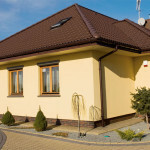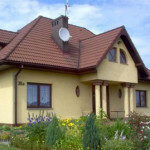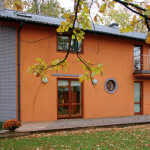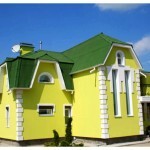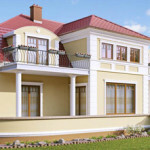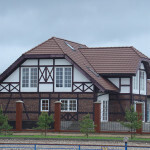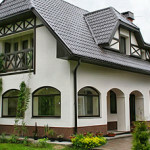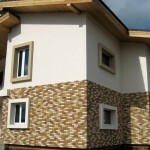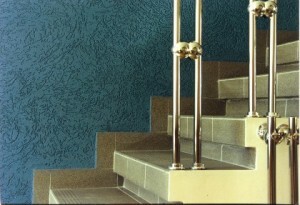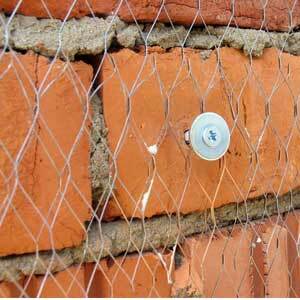Plaster facade on the grid (30 images): plastering and lining
Table of contents
-
1 What may be mesh
- 1.1 tissues
- 1.2 Rabitz
- 1.3 welded
- 1.4 Expanded metal
- 2 facade plastering
- 3 Facing finish
- 4 Summing up
- 5 Photo Gallery
The mesh increases the strength of the solution when applied to large areas, and the transitions between the different wall materials. The plaster on the grid of the facade is necessary when working in the new buildings, the walls of which still give a precipitate.
The reinforcing material may be metallic, polymeric or fiberglass. His choice depends on the application.
What may be mesh
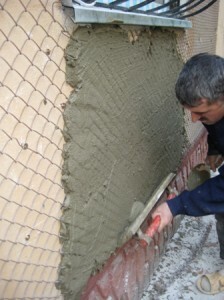 Often applied to the concrete, brick and wood finish facades crack and peel off. To avoid this, the surface of the reinforcing mesh.
Often applied to the concrete, brick and wood finish facades crack and peel off. To avoid this, the surface of the reinforcing mesh.tissues
Woven mesh. This is a subtle, but strong and flexible material, woven by weaving wires of different sections. For plastering walls with his hands using a grid having square cells 1 × 1 cm, and the zinc coating. Sold in rolls.
Rabitz
Knitted mesh or netting having a diameter of 2 cm cells, used to reinforce large segments.
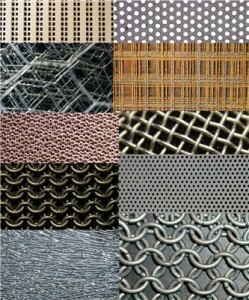
Types of Metal Mesh
welded
Welded wire mesh has square cells. Made by means of spot welding intersections of wire rods which are perpendicular to each other. The material is galvanized or coated with a polymeric composition bright low carbon wire. Welded mesh is used to prevent cracking of the finish, with the active sludge. We recommend the use of the net with a mesh of 2-3 cm.
Expanded metal
Manufactured on a special press from sheets of metal. The resulting material has a diamond-shaped cells which are arranged in staggered rows. Used with a relatively small flow of plaster of 1 m2. The rolls have a width of 1 m.
When a sufficiently thin layer of plaster is used fiberglass mesh or polymers.
facade plastering
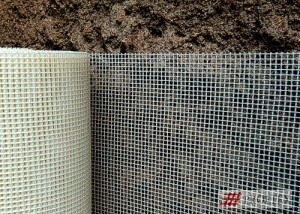
Polymer network (price - 2150 rubles).
Use of a metal mesh when applying a finishing layer of 3 cm and above. Netting is used for the reinforcement has nothing prepared the walls under plaster.
Roll the netting roll. Measure the height of the tape surface of the roof to the ground. Cut the desired number of panels on metal scissors.
Spread and lock the grid by screws or nails onto the primed surface so that adjacent webs overlapped by 10 cm.
Knead with antiseptic solution. Last will ensure that on the surface appear mildew stains.
The first primer solution throws spatula or a trowel and level regulation. Allow the mixture to dry and apply the second planarization layer. He is thinner, so spread it with a trowel or a large spatula.
If the mass lay unevenly, after it is completely dry we recommend to use the finishing putty. When it hardens, touch up small skin irregularities.
The polymer mesh is often used when applying textured plaster with your hands. It has chemical resistance, however it does not spoil the finish coat during operation.
Measure with a tape measure and cut fabric mesh. If the substrate is thick, to apply a thin layer of mortar and press it into the reinforcing material. If the walls are porous or wood, you can fix a stapler grid.
Securing it uniformly distribute mass over its entire surface so that the network is not peeped out.
The plaster on the grid - with polymer technology:
Begin applying the solution from the middle of canvas and continue working toward the edges, if you kleite wallpaper and being kicked out of their air.
Note! Polymer networks have flexibility, so stretching. Work carefully and avoid the formation of bubbles of a reinforcing material.
Facing finish
The most common method of applying the topcoat as plastered exterior walls of buildings and internal - it is their color. Before work rate the quality of a base, if necessary seal the cracks make sure that the layer has a strong bond with the surface, does not flake and wall zashpaklyuyte.
- After curing putty, sand the surface skin. Before painting, distemper treat the area of water primer. Great care Treat the question than to paint the plaster.
Note! If the decoration is fresh, it may have an excess of alkali so apply formulations based solvents undesirable. Using organic solvent inks, keep in mind that the surface must be protected synthetic primer.
- Stained roller, carefully and without any gaps treating the entire surface. Once the first coat of paint dries, apply a second.
Council on the topic than to paint stucco facade. It is better to use for this purpose, alkyd, acrylic and latex formulations.
- Indoor topcoat second most popular are the wallpaper, which will also require careful preparation.
- Remove old wallpaper, if any. Before you glue the wallpaper on the plaster, make sure it is firmly.
- Rinse the cleaned surface with water and check for cracks. If necessary, seal the filler.
- The treated areas to completely level sandpaper.
- Prepare glue for wallpaper.
On the rolls is always a user gluing material and advice on adhesive selection. Technique work with the wallpaper on the plaster walls is different from similar operations on other surfaces.
Summing up
We hope our article has been helpful to you. In order to more accurately understand the technological and practical issues on our website provides detailed photo and video instruction, in which you will find useful information on the question.
Photo Gallery
